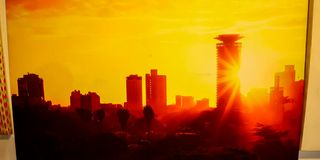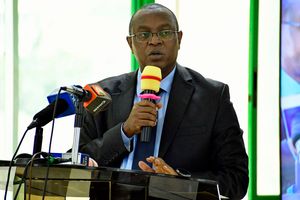
Mutua Matheka a travel and architectural photographer at Kilimani, Nairobi on October 15, 2024.
The kind of photography that Mutua Matheka does is never too far from danger.
He has been arrested at least four times, he once dropped an expensive camera from the 27th floor of a building, he has been pelted with stones by people who did not take kindly to him pointing a camera at them, to name but a few.
His job description is – guess it – architecture photographer. He also does travel photography.
He is an architecture graduate who took a detour from what he was trained to do for a living and took the path that appealed most to the artiste in him.
He roves about town armed with a camera, his index fingers itching to jolt the shutter to freeze a moment in time. Most of his movement involves looking for the best spot to photograph buildings and structures.
Getting that perfect spot can be a problem. Locating the perfect building is an even bigger problem.
That is how he dropped his camera one day. To get unique shots of Nairobi and other cities, he often looks for vantage points on storey buildings. One day, that endeavour went wrong and the camera went tumbling down.

A photo of the Nairobi skyline by Mutua Matheka, a travel and architectural photographer at Kilimani, Nairobi on October 15, 2024.
Street children who witnessed the fall pounced on the memory card that jumped from the flying camera pieces. When he descended to take stock of the mangled mess his camera had become, the children demanded Sh5,000 from him for the memory card. He bargained the price down to Sh1,000.
“Thankfully, I got the pictures because the card was okay,” he says.
About the arrests, it is all to do with police who never trust the intentions of anyone photographing buildings in the city.
He says the sensitivity about snapping shots of buildings began when terror attacks inside closed spaces started becoming frequent.
“It became very hostile for photographers,” he says, adding that the coming into force of a new anti-terrorism law did not help matters.
“I’ve been arrested a total of four or five times. We never go to jail because it [photography] is not against the law, but we just spend maybe the whole day at the station. They look at all the pictures [we have taken],” he says.
“The longest I’ve stayed there is like six hours, waiting for the OCPD [Officer Commanding the Police Station].”
The last time he was arrested, it was on a Sunday at around 8am.
“Cops saw us, arrested us, and took us to Central Police Station. We were released at around 4pm or 5pm. The OCPD came, asked what the problem was. I said, ‘Yeah, I was shooting.’ He asked, ‘What were the pictures for?’ I said, ‘Instagram.’ I showed him the account where we post our pictures. He looked at them and said, ‘Well, nothing looks like it’s a problem but, you know, because of the terrorism, you can’t just do this. You have to notify us,’” he says.
He is happy that Nairobi City County permitted photographers to go about their business without pressure from askaris.
He has also engaged in photography outside Kenya (his goal is to photograph all African cities), and he remembers an incident in Zimbabwe.

Some of the artwork by Mutua Matheka a travel and architectural photographer at Kilimani, Nairobi on October 15, 2024.
“I’ve faced a bit of some violence in Harare. Some people threw stones at me and the people I was with. Some hawkers thought I was photographing them, but I was shooting over this bridge where they were selling wares underneath, and they are having some issues with the government at that time,” he says. “They threw stones, and I ran away quickly. So, I’m used to hostility. If it’s not the police, sometimes it’s hawkers.”
Despite the setbacks, he has every reason to enjoy his endeavour. As we have a chat at the ProKraft Africa offices in Nairobi’s Kilimani, he does not look like a man who regrets branching away from the profession he spent five years studying at the Jomo Kenyatta University of Agriculture and Technology (JKUAT).
In fact, he reckons that he is still very much contributing to architecture.
“The interesting thing about architecture is that it really opens you up to creative pursuits. You realise that there’s so much you can do creatively that is exciting. And so, in this process, I discovered photography in my fifth year of architecture studies. I didn’t think I would take it seriously; I thought it would always be a hobby,” he says.
“But then two years into employment, my photography was rising even as I was in employment. So, I needed to choose between quitting to start my own practice as a photographer or just continuing as an architect. I just choose to take a chance on myself. That was 12 years ago,” he adds.
He says he makes his money from architectural companies and other businesses.
“I’m an architecture photographer but also a travel photographer, which means my clients are hotels, interior architects, architects, and even real estate agents who need me as a service provider. I do that and they pay me for it,” says Mutua.
Some cogs moved inside Mutua on the day he saw Nairobi from the Kenyatta International Convention Centre (KICC) rooftop in 2010. He says he checked online and could not find a depiction of Nairobi close to what he saw. It inspired him to do something different.
Mutua will, from October 25 to November 10, be running an exhibition of some of the best shots he has taken of Nairobi over the years. These will be presented at the Junction Mall in the form of time-lapse videos.
He has designed the exhibition, whose tickets are on sale, to be a multi-mirror affair where a person enters a room with mirrors on the side, below them and above them. As they savour the audio-visual material on the screen, they will have a moment of reflection—literally.

Mutua Matheka, a travel and architectural photographer during an interview at Kilimani, Nairobi on October 15, 2024.
“The way I will be showing the film is a very immersive, interesting way because I don’t think it has been done here before, and it’s not a way that I’ve seen before. I’m building an enclosure. Normally, you would sit in a theatre to watch a film.
“But the way I’ve made this film is that I’m putting people in a box, then I give them headphones. They will be having a personal experience. The box will not hold more than five people at a time.
“On one side of the box is the screen showing the timelapse. On all the other sides are mirrors. The effect this has is that whatever is shown on the screen will be reflecting on the mirrors continuously. And at the same time, there’s also mirrors on the ceiling and the floor,” he says.
“I’m hoping that someone will feel like they are inside a kaleidoscope,” he says.
This will be his first full-fledged solo exhibition and, as we conduct the interview, he is worried that he might be late for a crucial afternoon shoot.
Time is of the essence for him because light is the backbone of photography. Delay a bit and the sun will move too far.

Mutua Matheka a travel and architectural photographer poses for a photo during an interview at Kilimani, Nairobi on October 15, 2024.
Asked what it takes to be a good photographer, he replies: “Number one, the openness and the willingness to try new things… Basically being open to new processes, new ways of seeing new ideas.”
Number two is to not just rely on inspiration to get work done, but to actually show up and get work done,” he adds.
He is also keen to do things right, and that is why he remembers paying as much as Sh40,000 to buy the rights to photograph a model.
“Copyright is something that has to be on the forefront of your mind if you’re an image creator,” says Mutua.
Two days after the interview, he keeps his word and shares some of the shots he has taken of Nairobi over the years, which will be part of his exhibition titled “Fragmnts”. Most of them have been taken from rooftops, looking down the city in the twilight.
Looking at them, one will notice the curious eye with which he looks at the city. Even a dyed-in-wool city resident will wonder whether they really know Nairobi.









